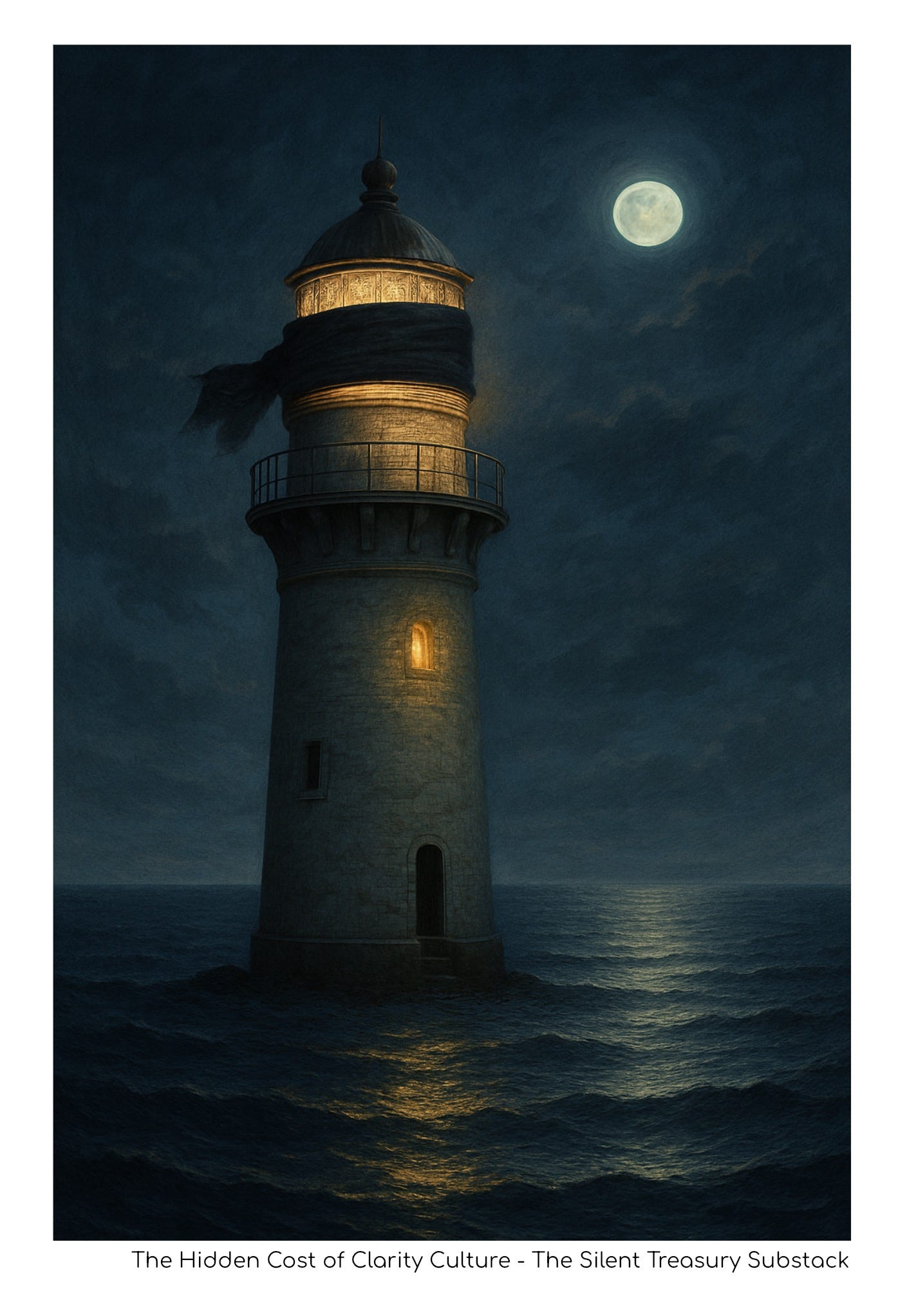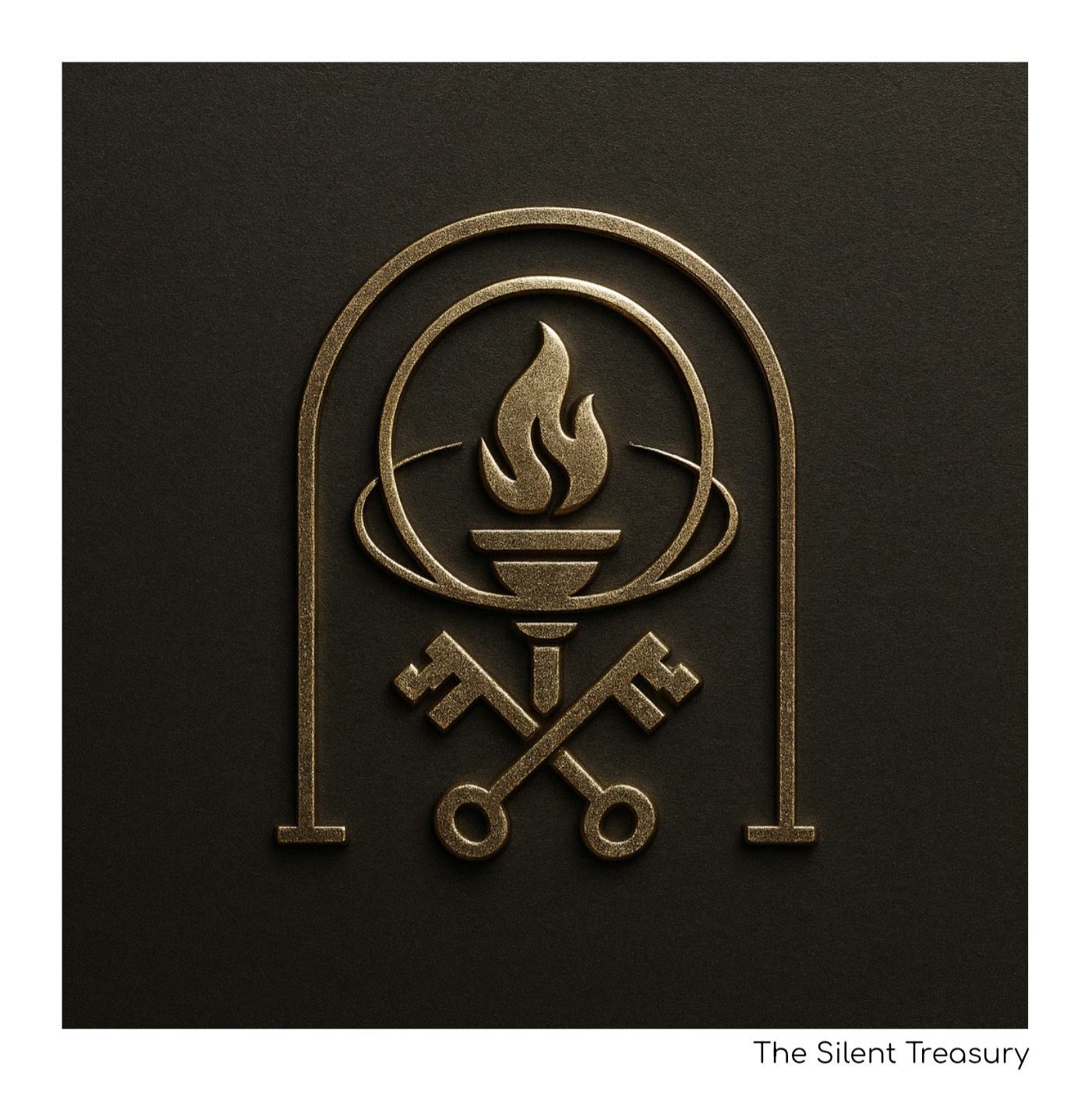The Intelligence Trap: Why Clarity Can Make Us Blind
Why Our Craving for Certainty Erodes Judgment, Mutes Signal, and Blocks Emergence
Clarity’s Masquerade — When Harmony Becomes a Cage
This is a portal carved for those who’ve felt the quiet weight of irreversible, long-term decisions
and sensed the subtle exhaustion behind our obsession with being right—fast.
For stewards, founders, builders, creators, and allocators…
those who live inside high-stakes decisions—this is for you.
If you’ve lived through the performance of alignment
and felt the invisible cost of simplification…
If you’ve nodded in rooms where the clarity felt too clean and safe —
and walked out sensing something sacred was being flattened in our pursuit of quick certainty…
Welcome Home. You are not alone.
Originally, clarity was a signal of survival. In hostile environments, it meant a shared understanding — a way to align, act, and endure. But over time, what began as a tool for convergence calcified into a performative script. Clarity stopped serving emergence and started enforcing control. We forgot its root function: not to impose answers, but to create the conditions for better questions.
This is the first of our signature, multi-part series on decision-making architecture.
In this opening part, we explore a subtle erosion—one that hides behind our pursuit of clarity.
We examine how premature resolution, when mistaken for wisdom, can dull risk perception, flatten judgment, and silence signal, especially in long-horizon, high-stakes decisions where emergence matters most.
We do not chase answers.
We illuminate tensions.
Not to confuse, but to liberate —
from clarity addiction,
toward coherence cultivation.
Worship at the Altar of Certainty
Clarity has become currency.
This clarity — fast, executable, palatable — becomes a kind of performance.
In boardrooms, capital calls, and leadership retreats, it’s the loudest ask:
“Give me an answer I can act on now?”
“What’s the story?”
“Where’s the clarity?”
But beneath that demand lives an unspoken addiction—
to control, to knowing, to clean lines.
We crave crispness because it soothes the limbic system.
But at what cost?
Clarity flattens. Discernment deepens.
Coherence—when patiently earned—offers more than emotional relief.
It doesn’t just soothe—it steers.
A slower, sturdier compass in markets where velocity is confused for insight—
not by simplifying tension, but by metabolizing it into long-range discernment.
Alignment as the New Aesthetic of Compliance
We don’t just chase clarity.
We build entire architectures around it:
Frameworks that simplify,
Strategies that script,
Templates that replace thinking with posture.
We mistook scaffolds for scripture.
Decks became doctrine.
Narrative replaced noticing.
And performance stood in for perception.
And it worked—until it didn’t.
Because in truth:
Not all insight is linear.
Not all complexity can be reduced.
And not all wisdom is immediate.
Across domains—from board-level consulting theatre to systems design—we see it:
the illusion of clarity muting what matters most.
The Cost of Performed Clarity
We’ve seen it before—
Picture a founder prepping for an investor meeting.
The numbers are clean, the narrative rehearsed.
But inside, a deeper truth resists translation.
The risk isn’t the pitch—it’s that something vital goes unspoken.
Because the cost of “clarity” was paid in silence.
That moment in the boardroom when the deck is pristine, the forecast airtight—
but the cxo builder looks down, uneasy.
Because the numbers are right, but the timing is wrong.
Because it’s clear, but not true.
We trade discernment for deliverables.
Judgment for velocity.
Signal for performance.
We confuse knowing with understanding.
And confuse coherence with convenience.
Half-Eared Power and the Perfume of Illusions
Clarity’s Distortion Field at the Summit
Clarity culture wraps itself in the language of efficiency, communication, alignment.
But beneath its glow lies an unspoken cost—one that flattens complexity, rewards performance over perception, and punishes the kind of discomfort that leads to actual strategic depth.
Senior leaders often confuse clarity of message with clarity of mind.
They mistake presentation coherence for strategic coherence.
And because they’re insulated from first-order signals,
they rely on secondhand clarity: polished updates, rehearsed narratives, sanitized dashboards.
But real intelligence is lumpy, slow, often incoherent.
When your entire system is optimized for “clarity,”
it will exclude signals that carry contradiction, tension, paradox.
Over time, this leads to structural illusion.
Leaders start making decisions within the hallucination of understanding.
And the organization begins to reward narrative over noticing.
The Unnamed Price of Premature Knowing
There’s a simple test for premature clarity:
If the clarity feels emotionally relieving but strategically hollow, pause.
If a decision soothes alignment but silences dissonance, investigate.
If clarity arrives faster than tension resolves — slow down.
Because speed is not signal. And relief is not resolution.
We rarely name the cost of clarity that arrives too early.
It doesn’t detonate. It erodes—quietly, structurally, systemically.
Here’s how it shows up:
Misaligned Decisions
We act on maps sketched in haste—before terrain reveals itself. Trade-offs are lacquered with optimism. Risks stylized into stories. Language becomes anesthesia. Performance, a stand-in for wisdom.
Intellectual Fragility
When narratives are oversimplified, we lose our tolerance for nuance. Discomfort gets pathologized. Tensions hidden. Paradox gets bypassed. Contradictions dissolved.Cultural Hollowing
Dissent and dissonance is mistaken for disloyalty. Real thinking retreats.Systemic Blindness
Over-defined lenses prevent emergence. We stop sensing slow-burning risks, second-order effects, and systemic ripples.Quiet Erosion of Trust
Stakeholders may not say it—but they feel when something doesn’t fit. Eventually, alignment turns hollow.Loss of Judgment
The longer we perform certainty, the harder it is to discern signal from noise. Over time, true clarity atrophies.
These aren’t abstract failures. They’re fractures in how we navigate complexity.
This is how systems sleepwalk into collapse:
through the cumulative safety of oversimplified maps
and the absence of anyone willing to say, “this doesn’t fit.”
The Wisdom Hidden in Contradiction
What if not-knowing isn’t a flaw—but a signal?
What if ambiguity is the condition for emergence?
Clarity addiction is an epistemic failure mode—
a distortion of reality that pressures leaders to resolve tensions prematurely.
The paradox:Our deepest insights don’t emerge in clarity, but in discomfort.
Our sharpest judgments arise not in control, but in pause.
A system addicted to clarity builds faster slides.
A system anchored in discernment builds enduring sense.
One seeks alignment. The other earns coherence.
Every founder and builder knows the feeling:
That moment when clarity arrives, but something inside recoils—
Because you know it’s too soon, too neat, too seductive.
Discernment isn’t clean. It’s metabolized.
And it demands reverence for what cannot yet be named.
We’ve seen it in the field:
The CEO who rallied the team around a too-early North Star—only to pivot six months later at ten times the cost.
The VC / PE allocator who forced a clean forecast in a nonlinear market—eroding trust with the founders they backed.
The Board / Custodian that chose polish over tension—and spent years undoing what was silenced in that one neat deck.
Each decision was “clear.”
None were wise.
Choosing the Sacred Over the Shippable
What would it mean to lead without rushing to clarity?
To hold:
Multiple truths without collapse,
Stakeholder tensions without panic,
Systems without oversimplifying them into slides?
This isn’t a call for vagueness.
It’s a call for depth.
A deeper architecture of decision-making—
one that honors ambiguity not as weakness, but as signal.
Truth doesn’t arrive. It unfolds.
We need epistemic scaffolds, not performance theatre.
We need decision hygiene, not thought choreography.
We need discernment, not just direction.
In board-level consulting theatre, leadership psychology, or investment committees—
the same overcorrection emerges:
an allergy to ambiguity that sterilizes wisdom before it forms.
There’s a difference between systems that optimize for appearance—
where clarity is performed, exported, and rarely questioned—
and systems that cultivate discernment:
where complexity is held, internal cognition is respected, and timing is sacred.
For those building what must endure:
This is not a mockery or rejection of clarity — it's a call to stop worshipping it.
To see where it serves — and where it sedates.
To notice when it amplifies signal — and when it amputates sense.
This is a devotion to coherence.
Quiet Mirrors
For founders who’ve pitched clean decks while something essential stayed unsaid—
For capital allocators who’ve watched insight thin as metrics multiplied—
For stewards and custodians who’ve inherited the cost of someone else’s certainty—
For advisors who’ve held space while others performed knowing—
This frame may feel familiar.
You’ve been in that room—
where the silence after the “yes” said more than the pitch.
You’ve walked out of the meeting—
knowing the numbers aligned, but the instincts didn’t.
You’ve nodded through the certainty—
while something inside you whispered, “Not yet. Not like this.”
You’ve stayed with the tension.
You’ve sensed when clarity rang too neat, too soon.
You’ve chosen coherence over choreography.
What you’re building asks more of you.
Not faster answers. But a deeper architecture—
one that sharpens not just your strategy, but your self.
The Return to Sensing
The Hidden Cost of Clarity isn’t philosophical.
It’s visceral. Strategic. Cultural. Emotional.
It costs us:
Integrity of signal.
Quality of judgment.
Capacity for emergence.
Picture a scaffold, not a stage.
A space for signal to settle.
Where noise is not projected, but quieted.
Where judgment is forged, not performed.
Discernment doesn’t arrive as answers.
It deepens in stillness.
Like seasoned wood, it endures not by construction—but by time, tension, and grain.
It holds because it was weathered.
This is not consulting theatre—it is the discernment scaffold.
We were never meant to outsource our sensemaking.
Not to frameworks. Not to playbooks. Not to consultants.
To crave clarity is human.
To resist premature resolution is leadership.
This piece is a mirror.
For those who’ve endured clarity theatre—
and are ready to lead differently.
May it sharpen your discernment.
May it soften your rush to certainty.
May it quiet your inner architecture—until signal returns with integrity
We’ve seen quiet leaders, across sectors and geographies, return to this frame—
to recalibrate, reflect, and re-enter complexity with slower eyes.
If it serves that purpose again, let it.
Snippets for Reflection
Clarity flattens. Discernment deepens.
Truth doesn’t arrive. It unfolds.
Clarity soothes and sedates. Coherence signals and steers.
What is rushed may resonate in a quarter—but rot in a decade.
Judgment is seasoned, not scripted.
Discernment begins not in the brilliance of clarity—but in the shadow it casts.
Coherence can’t be hacked or hurried.
What soothes the room may betray the system.
Not all signals shine. Some hum beneath language.
Certainty is comfort. Discernment is cost.
When the dust settles
Thank you for experiencing the work.
In the upcoming parts of this signature series,
we’ll explore living tools to anchor signal in chaos—
like a decision rubric, a polarity map, or a clarity-cost matrix—
not to impose order, but to restore coherence.
These tools are designed for founders, builders, creators, and stewards navigating irreversible, high-stakes decisions—
where clarity seduces, but coherence sustains.
If the piece resonates—
You are not alone.
This is your Sanctuary.
Welcome Home.
If it unlocked something unspoken,you know what to do.





Brilliant. This eloquently captures the root cause of intellectually suffocating and emotionally exhausting work in an environment that demands simple answers to complex, multivariant problems — a place where strategic nuance is drowned by executive impatience and the pathological pursuit of immediacy.